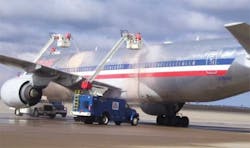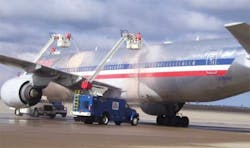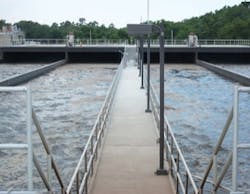Sound Airport Deicing Fluid Management
By Scott Wallace
Airplane deicing requirements have made air travel in winter months safer, but airport managers worldwide are now coping with new regulations as the environmental impacts of the practice are now coming under regulatory scrutiny. Although the glycols typically used for deicing are readily treatable, creating a steady state of predictable flow and concentration for treatment is an engineering challenge.
Many major international airports are operating management systems to handle these fluids. A wide range of practices are currently used ranging from sophisticated recycling units to simple aerated lagoons. The systems reflect the deicing activity of the airport in which they are installed and are tailored for the climate and air traffic.
Source reduction, containment, stormwater treatment, and disposal are four key areas to consider when treating glycol contaminated stormwater. The importance of each area differs depending on the airport. In some cases, an airport may choose to completely do away with glycol-based deicing activities in favor of non-chemical means such as infrared heating. In other cases, an airport may have the luxury to dispose of all wastewater to a sewage plant. For the rest, some form of treatment is necessary.
The nature of the deicing wastewater must be considered by engineers who need three pieces of data to design a treatment system: the strength of wastewater, the required quality for discharge, and the volume and its fluctuations. In most cases, these pieces are easy to define resulting in the stepwise development of a treatment system.
The environmental effects of jet deicing fluids are mostly related to the high oxygen demand they exert when released to rivers and streams. Removal prior to discharge is critical. In most cases, surface water permits limit discharge of BOD to below 30 mg/l.
The environmental effects of deicing fluids are mostly related to the high oxygen demand they exert when released to rivers and streams. Fish and other organisms that need aerobic environments can be killed when a large slug of glycol depletes the dissolved oxygen in receiving waters. Removal prior to discharge is critical. In most cases, surface water permits limit discharge of BOD to below 30 mg/l.
Technical challenges
Most deicing areas are constructed to provide quick drainage as reflected by the pipes and drains around an airport. Though necessary for keeping gates and pads free of ponding water, this “flush and forget” approach results in the potential for downstream flooding. To combat this, airports have incorporated stormwater storage tanks, vaults, and ponds to shave peak flows. With large airfields producing significant runoff, stormwater storage volumes can be massive and are typically sized in the millions of gallons.
Though effective at buffering peak flows, these large storage volumes are not usually piped to capture the initial first flush of a storm. This is the period of time that generally contains the largest concentrations of pollutants. Civil engineers are increasingly aware of this and are incorporating front-end quality control volumes into stormwater management systems. The dirty, first flush that is captured is pulled aside during a storm event and treated.
Recovery
Up to 40 percent of glycol can be recovered and recycled or treated. A significant percentage of the remaining portion does end up in stormwater and can have concentrations that greatly exceed sewage.
Airports with centralized deicing pads are well suited for recycle of high strength flows. Distillation, vapor recompression, and reverse osmosis units are being used to clean up and concentrate some of the stronger concentrations of deicing fluids. In these systems, dilution by stormwater is the enemy and great effort goes to collecting and storing the concentrate prior to processing. The systems perform best when concentrations are in the 8 to 12 percent range, though work with reverse osmosis and filtration units can be done on concentrations above 1 percent.
Pittsburg, Denver, Salt Lake City, Detroit, and Minneapolis are some of the airports that have worked on recovery systems. Advances in filtration units and increased competition have allowed many airports to consider recovery as an attractive option to treatment.
Wetlands Case Study
An innovative approach using aerated wetlands was constructed in 2008 at Buffalo Niagara International Airport (BNIA) and went online in 2009. The catalyst for BNIA project was compliance with a State of New York stormwater permit, which limits the concentration of biochemical oxygen demand in stormwater to 30 mg/l. Another regulatory restriction on the project is the volume of stormwater discharge to Scajaquada Creek to the south of the airport. The discharge from the southern half of the airfield is limited to a maximum flow rate of 181 CFS, which effectively translates to 154 CFS for the project area. To meet this restriction, the airport previously constructed a stormwater system with a three million gallon vault. Pumps from the vault discharged to a culvert feeding Scajaquada Creek.
Based on a needs analysis, a vertical flow configuration was selected in which stormwater is distributedAeration Lines: Five feet of technically specified aggregate top the aeration and drain lines.
Filling the Beds: The four aerated gravel beds were constructed adjacent to the airfield with minimal hindrance to airfield operations.
The below-grade gravel beds are designed to treat spent glycol found in stormwater during deicing season. Aeration of the gravel is critical. The system is designed to supply oxygen to bacteria attached to the gravel and can be controlled relative to the level of glycol being treated. Currently, the system is designed for 10,000 lbs of oxygen demand per day and is roughly the size of four football fields.
The flow and concentration of the stormwater will be closely monitored using electromagnetic flow meters and online analyzers and controlled as needed to optimize performance of the wetland. Air and nutrients will be supplied to the system to match the pounds of glycol measured. The patented Forced Bed Aeration system is fed by four 250 HP positive displacement blowers and is used to distribute air uniformly over the floor of each bed. The operation of blowers can be modified to match the level of glycol being treated. Supplemental nutrients, nitrogen and phosphorus, can also be paced into the influent relative to organic loading to match nutrient requirements for bacterial growth.The system is engineered to maintain an active biomass within the wetland throughout the winter. It is built below ground with an insulating mulch layer on top so as to maximize water temperature. During the warmer summer months, the accumulated biomass will degrade and be consumed by larger “bugs” that graze on the slime-covered gravel. This natural digestion of biosolids is a seasonal means for managing “sludge” generated in the treatment of the glycol.
Come spring and the close of deicing season, the wetland treatment system will be used as a tool in the management of stormwater volume. The water level in the gravel beds is fully adjustable allowing the operator to use the beds to buffer the flow from summer storm events. Since the system is already piped for managing peak flows, no additional infrastructure modifications are necessary. The beds provide treatment in the winter and storage in the summer.
Conclusion
How each airport takes on glycol management will vary from site to site; the peculiarities of each airport will drive the process for treatment and the solution. How much deicing activity is there? What are the options for disposal? What is the existing infrastructure at the airport? Each facility will need to answer these questions, which will then channel the solution in a different direction. Many possible solutions for airports can be considered, so it is imperative that airport managers and their engineers look at all the factors affecting their deicing operation and the available options before starting down a treatment path.
About the Author: Scott Wallace is a Principal with Stantec NAWE. Scott is a leading expert on constructed wetlands, and was Principal Investigator on behalf of the Water Environment Research Foundation (WERF) for Small-Scale Constructed Wetland Treatment Systems. Scott was also the co-author of Treatment Wetlands, Second Edition, which is considered to be the definitive textbook on wetland design. He consults on a wide variety of projects across North America, Europe and Asia.




